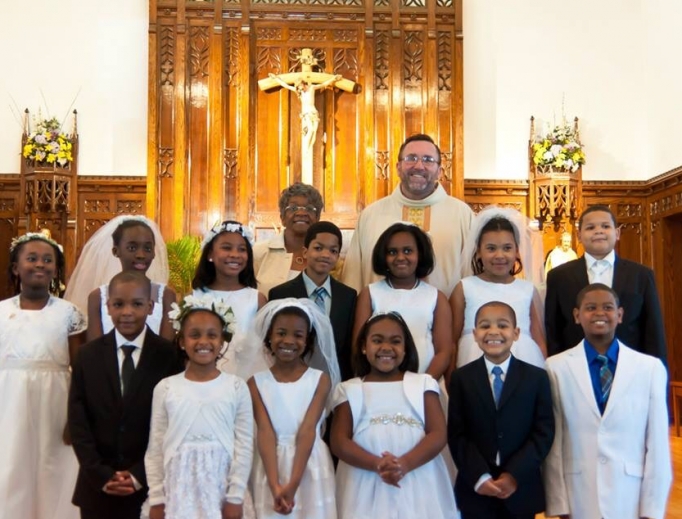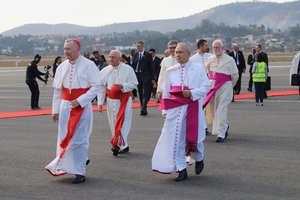What’s the Secret for Parishes to Thrive Under Pandemic’s Financial Pressures?
Parishes coping effectively have cultivated discipleship, transparent and accountable stewardship, and co-responsible governance.

PHILADELPHIA — “We had no fear going into this.”
Father Christopher Walsh’s response is not what one would expect of a pastor during the COVID-19 pandemic shutdown, contemplating its potential negative financial impact.
Most Catholic parishes and dioceses have looked at the shutdown as a financial doomsday. But not at St. Raymond of Penafort, a majority African American Catholic parish in the northwest corner of Philadelphia. In fact, according to Father Walsh, the parish collections actually are up 2% from last year.
The reason, he explained, is “our parish remains relevant in people’s lives.”
But in fact, the parish is far from the only one that is doing well, thanks to a culture of discipleship, transparent and accountable stewardship, and co-responsible governance that many leading Catholic experts say is overdue and essential.
St. Raymond’s typically sees 400-600 parishioners worshipping on a weekend. The parish is discipleship-driven, with a strong sense of stewardship for a parish they see as their common church home. “It’s the people’s parish,” he said. “They’re not welcoming people to Father Chris’ church; they’re welcoming people to [the parish as] their family.”
“The only way we grow the Church is to invite people,” he said.
And parishioners have a voice in collaborating with their pastor in carrying out the work of the Gospel. Father Walsh said his predecessor wisely cultivated parish leaders and volunteers who were representative of its members. It is key to help “people understand their role in the church” and develop their gifts and talents to carry out Christ’s mission.
When COVID-19 hit, the pastor gathered together his parish staff and volunteers to do a brainstorming session. And they not only pivoted their activities, such as small discipleship groups, to online video chatrooms, but they added prayer meetings and upped their direct digital engagement, including forums on how to help parents home-school their children.
“That [online meeting] was probably the smartest thing I did,” Father Walsh said.
Buying Time to Change
Approximately 12,000 Catholic parishes applied for Paycheck Protection Program loans meant for small businesses and nonprofits to keep staff on payroll, and 9,000 received them.
For these Catholic parishes, the loans (which may be turned into grants so long as they keep people on payroll) may buy them critical time to reorganize and reform on solid practices and footing.
Kim Smolik, CEO of the Leadership Roundtable, told the Register that COVID-19 has only “accelerated and amplified” a damaging financial trajectory for the Catholic Church in the U.S. Following the Pennsylvania grand jury revelations and the Theodore McCarrick scandal in 2018, 26% of Catholics said they were reducing their giving, and one out of four Catholics said they started attending Mass less, according to a 2019 survey from the Pew Forum.
And the Center for Applied Research in the Apostolate (CARA) “1964” blog reported April 23 that, on average, Catholic parishioners gave $9.43 per household per week to their parish.
“That was before Sunday Masses were not taking place,” Smolik said.
Studies such as the 2015 “National Congregations Study” from Duke University have shown Catholics give half of what evangelical Protestants do at similarly sized congregations across the board. Likewise, the University of Notre Dame Institute for Church Life report showed Catholics have the lowest tithing rate to their church than any Christian religious group.
But Smolik emphasizes that these numbers are not inevitable, so long as a parish and its diocese realize they need to embrace a model of laypeople and clergy exercising “co-responsibility” for the local Church.
“We all have to be open to innovation,” she said.
The discussion about co-responsibility is recent, but the concept itself is hardly new in the life of the Catholic Church. A study of pre-Reformation English Catholic Bristol by Clive Burgess showed laity in the late medieval period played a far more active and key role in ordinary parish governance than typically seen today, particularly in financial matters, which allowed the clergy to concentrate their energies on the spiritual dimension of their mission.
Smolik said Leadership Roundtable created online resources for parishes and dioceses to help them find new approaches. Smolik recommended having lay and competent personnel at every level, including an active finance council.
“Make sure there is a diversity of representation and that there is access to that finance council,” she said.
And it was also key for pastors and their councils to have regular communication with parishioners through video, letters and any other appropriate mechanism to show their commitment to exercising co-responsibility for the parish.
“There’s no room for the status quo,” she said.
Generating More Giving
The Catholic Church’s parishes in the U.S. were bringing in $6.3 billion a year, according to an estimate by CARA’s Mark Gray on the center’s “1964” blog. Gray estimated that with COVID-19’s shutdown of Catholic parish life, parishes may only be bringing in 42% of their pre-pandemic collections.
Charles Zech, founder of Villanova School of Business’ Center for Church Management and one of the foremost experts on the Catholic Church’s financial management, told the Register that the Church’s financial picture would be drastically different if Catholics gave at the same rate as Protestants.
“We’d have another $9 billion a year,” he said. Zech said that number could be reached with Catholics increasing their giving to match Protestants, giving on average 2.1% to 2.5% of their annual income to their parish.
Zech explained that a number of problems account for the variance between Catholic and Protestant levels of support. But most of them have solutions that can be worked out at the parish level.
For one thing, Zech said, 38% Catholics in his studies told him that they give weekly based on what was in the checking account at the moment, which gets less each week as the month depletes their checking accounts.
Protestants, by contrast, do better overall than Catholics at imbuing people with the concept of “tithing” or “pledging” a percentage of their income, which means they budget in their giving.
Online giving, he said, is really a form of pledging. It also means churchgoers continue to support their parish whether they are there or not. But before the pandemic, Zech said only a quarter of Catholics gave online.
”If they’re not at Mass on Sunday, they don’t make up the difference,” he said.
But Protestants, Zech explained, have more confidence than Catholics in how their church is spending their money. Protestant leaders tended to be “very transparent” with the church members in their finances and budgeting.
“If you want them to give more, they’ve got to have a say in how the money is spent,” he said.
Zech explained that parishes need to realize that they have to practice this same level of transparency. While an older generation of Catholics habitually would give to the Church without demanding transparency, the younger generations of Catholics will not unless they have “input in the decision-making process.”
Otherwise, the laity will simply put their generosity elsewhere in institutions that have their trust.
Zech explained clergy and laity can work better as complements in cultivating parish financial stewardship.
“The priest should preach on stewardship, that all we have is a gift from God,” he said. It is the task of the lay leadership of the parish, he said, to invite their fellow parishioners to be informed on the financial needs of their parish.
Zech explained that parish pastoral and financial councils need to be robust institutions capable of giving their pastors both “honest information” and “honest disagreement” when he makes his decisions — if these institutions are “rubber stamps” for what the pastor wants to do anyway, they are failing their duty.
Another key is parishioners have to feel close to and connected with their parish. In small parishes, he explained, people see how their support is critical to make a difference, so the per-household giving rates are higher. In larger parishes, he said, people feel the temptation of “free-riding” or the attitude of “If I give a little less, who will notice?”
Part of the necessary challenge of large parishes is to make the parish feel “small” through small groups to create that strong personal sense of belonging and that one’s financial support is essential.
Zech explained that if the Catholic parishes make these changes, COVID-19’s financial stress on the Church may prove to be a blessing in disguise.
“I saw no momentum for change until this happened,” he said. Above all, people have to see the parish adding real value to their life through their financial support. Without it, he explained, they won’t contribute.
St. Anne’s in the Bible Belt
St. Anne’s Catholic Church in Broken Arrow, Oklahoma, has managed to weather the COVID-19 shutdown’s economic efforts due to robust support from the parish that was in place before the crisis.
“We’re doing the best we can, and reaching out,” said the pastor, Father Matt Gerlach, saying his young parish staff has been a blessing in keeping the parish digitally connected through the shutdown. “We’ve not done very poorly at all.”
Collections are down $3,000 from the $19,000-a-week average they brought in each week from January until COVID-19 hit. But the decline since then has been slow, not sudden, indicating the income loss is largely from the prolonged economic downturn. In the first few weeks, Father Gerlach explained, giving stayed high, at around $18,000 per week.
“For nobody coming to church, it’s really amazing to see 16 grand,” he said. “We haven’t seen much of a deficit. … We certainly have been impressed by their faithful support.”
Father Gerlach explained a good swathe of people in the parish are supporting their parish financially. When COVID-19 hit, the pastor explained parish giving online went from 20% to 60% almost overnight.
But the reason for the high levels of giving are similar to those cited by St. Raymond’s in Philadelphia: The church is still active and involved in parishioner’s lives and in their community. It just has largely shifted to a digital format.
“For us specifically, it is because we’re still managing to connect with the parishioners,” he said. The staff keeps making calls, seeing how people are doing and if they have any needs that the parish could assist with. They sent out a letter to all parishioners about the Masses and activities they could access online, as well as about the on-site food pantry.
“People appreciate all we’re doing,” he said. “They support us in what we’re doing, and they’re continuing their giving.”
But the pastor said St. Anne’s has a “very strong” culture of stewardship, rooted in the call to discipleship that they have built intentionally over the past eight years.
“We talk about discipleship a lot,” he said. Stewardship of finances is placed at the service of the Gospel. The parish’s motto is “invigorate faith, build community, and go make disciples.”
But transparency and accountability is key.
“People are very trusting because we are transparent,” he said.
Father Gerlach said the finance council features people from the parish, with experts in their field. Parish staff and leaders are all there on Sunday to be present and responsive to questions. They issue an annual report on the church’s finances. They make sure the information is available at the welcome center in the church.
“We say stewardship is a way of life, and people see that,” he said. “They see the benefits of that in the pastoral services we provide and the outreach we’re doing.”
Peter Jesserer Smith is a Register staff writer.















